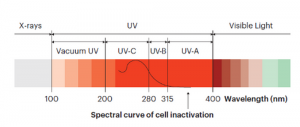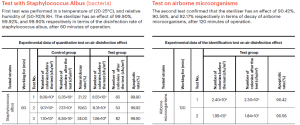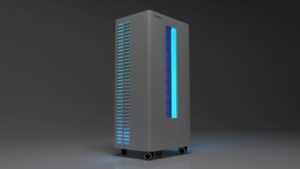UVC treatment is an established technology for disinfection that has been extensively applied since 1910, when it was discovered that it can neutralize microorganisms such as bacteria, virus, moulds, and yeasts.1 Hundreds of studies have been conducted during the past decades, showing the efficacy and safety of the usage of UVC lights in disinfection.2,3
Ultraviolet radiation is a range of electromagnetic radiation with a wavelength below the light visible by the human eye, and immediately above that of X-ray light. The UVC light is the smaller wavelength among all types, between 100 – 280nm. At 253.7nm, the UVC light has been shown to cause inactivation of microorganisms due to the UVC absorption and photochemical damage to the microorganism’s DNA and RNA, eliminating their capacity of replication, therefore neutralizing them.1,4

With the recent spread of respiratory diseases, the concern about keeping indoor environments and surfaces disinfected has grown considerably, and the usage of UVC light-based devices have been an important approach to reduce airborne contamination, therefore reducing the spread of some diseases.5
The FagronLab UVGI-80 Air Sterilizer is a device developed by the Fagron Group, a global pharmaceutical company present in more than 30 countries around the globe, to perform a full cleanse of contaminated environments, eliminating airborne microorganisms.
The operation of the UVGI-80 consists of a dynamic air circulation system, with a constant airflow of 800m3/h. The equipment pulls the air through a bilateral inlet, causing small particles such as airborne microorganisms to be directly exposed to 5 double UVC lamps, and then safely conducts the clean air back to the environment.
The device has been carefully designed to keep all the UVC lamps enclosed in its core, to avoid direct exposure to the eyes or skin, making it safe for use in rooms with human presence. Validation tests were performed and confirm that the device has no radiation leakage.
The UVGI-80 is suitable for air disinfection of potentially contaminated sites such as hospitals, pharmacies, medical waiting rooms, but also in places with high circulation of people like schools, universities, restaurants, offices, and commercial stores. Its capacity of neutralizing airborne microorganisms is reinforced by advanced scientific data on the usage and efficacy of UVC lights and has been demonstrated in several studies. When choosing a safety product, it is critical to ensure that the specifications are validated, and claims can be proven – FagronLab’s UVGI-80 has the data available to enable rational comparisons to be made and to justify investments of this nature.

Once the optimal disinfection plan is designed, you can rest assured that the device will operate effectively to protect staff and customers.
The use of the UVGI-80 requires minimal maintenance, with only cleaning and lamp replacement periodically, depending on usage. The device can be utilised according to a range of disinfection strategies, being suitable for continuous or occasional operation.
For further information and quotations, please contact Fagron South Africa at www.fagron.co.za or email info@fagron.co.za.
References and studies available on request.
1. Buonanno M, Stanislauskas M, Ponnaiya B, et al. 207-nm UV light – A promising tool for safe low-cost reduction of surgical site infections. II: In-vivo safety studies. PLoS One. 2016;11(6):1-12. doi:10.1371/journal.pone.0138418
2. Welch D, Buonanno M, Grilj V, et al. Far-UVC light: A new tool to control the spread of airborne-mediated microbial diseases. Sci Rep. 2018;8(1):1-7. doi:10.1038/s41598-018-21058-w
3. Kim D, Kang D. crossm UVC LED Irradiation Effectively Inactivates Aerosolized Viruses ,. 2018;84(17):1-11.
4. Ploydaeng M, Rajatanavin N, Rattanakaemakorn P. UV-C light: A powerful technique for inactivating microorganisms and the related side effects to the skin. Photodermatol Photoimmunol Photomed. 2021;37(1):12-19. doi:10.1111/phpp.12605
5. Walker CM, Ko G. Effect of ultraviolet germicidal irradiation on viral aerosols. Environ Sci Technol. 2007;41(15):5460-5465. doi:10.1021/es070056u

